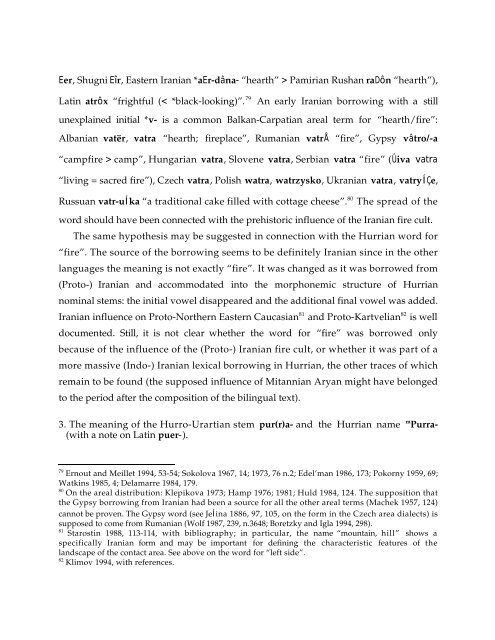Comparative Notes on Hurro-Urartian, Northern Caucasian
Comparative Notes on Hurro-Urartian, Northern Caucasian
Comparative Notes on Hurro-Urartian, Northern Caucasian
Create successful ePaper yourself
Turn your PDF publications into a flip-book with our unique Google optimized e-Paper software.
Eer, Shugni Eîr, Eastern Iranian *aEr-dâna- “hearth” > Pamirian Rushan raDôn “hearth”),<br />
Latin atrôx “frightful (< *black-looking)”. 79 An early Iranian borrowing with a still<br />
unexplained initial *v- is a comm<strong>on</strong> Balkan-Carpatian areal term for “hearth/fire”:<br />
Albanian vatër, vatra “hearth; fireplace”, Rumanian vatrÅ “fire”, Gypsy vâtro/-a<br />
“campfire > camp”, Hungarian vatra, Slovene vatra, Serbian vatra “fire” (Ûiva vatra<br />
“living = sacred fire”), Czech vatra, Polish watra, watrzysko, Ukranian vatra, vatryÍÇe,<br />
Russuan vatr-uÍka “a traditi<strong>on</strong>al cake filled with cottage cheese”. 80 The spread of the<br />
word should have been c<strong>on</strong>nected with the prehistoric influence of the Iranian fire cult.<br />
The same hypothesis may be suggested in c<strong>on</strong>necti<strong>on</strong> with the Hurrian word for<br />
“fire”. The source of the borrowing seems to be definitely Iranian since in the other<br />
languages the meaning is not exactly “fire”. It was changed as it was borrowed from<br />
(Proto-) Iranian and accommodated into the morph<strong>on</strong>emic structure of Hurrian<br />
nominal stems: the initial vowel disappeared and the additi<strong>on</strong>al final vowel was added.<br />
Iranian influence <strong>on</strong> Proto-<strong>Northern</strong> Eastern <strong>Caucasian</strong> 81 and Proto-Kartvelian 82 is well<br />
documented. Still, it is not clear whether the word for “fire” was borrowed <strong>on</strong>ly<br />
because of the influence of the (Proto-) Iranian fire cult, or whether it was part of a<br />
more massive (Indo-) Iranian lexical borrowing in Hurrian, the other traces of which<br />
remain to be found (the supposed influence of Mitannian Aryan might have bel<strong>on</strong>ged<br />
to the period after the compositi<strong>on</strong> of the bilingual text).<br />
3. The meaning of the <strong>Hurro</strong>-<strong>Urartian</strong> stem pur(r)a- and the Hurrian name m Purra-<br />
(with a note <strong>on</strong> Latin puer-).<br />
79 Ernout and Meillet 1994, 53-54; Sokolova 1967, 14; 1973, 76 n.2; Edel’man 1986, 173; Pokorny 1959, 69;<br />
Watkins 1985, 4; Delamarre 1984, 179.<br />
80 On the areal distributi<strong>on</strong>: Klepikova 1973; Hamp 1976; 1981; Huld 1984, 124. The suppositi<strong>on</strong> that<br />
the Gypsy borrowing from Iranian had been a source for all the other areal terms (Machek 1957, 124)<br />
cannot be proven. The Gypsy word (see JeÍina 1886, 97, 105, <strong>on</strong> the form in the Czech area dialects) is<br />
supposed to come from Rumanian (Wolf 1987, 239, n.3648; Boretzky and Igla 1994, 298).<br />
81 Starostin 1988, 113-114, with bibliography; in particular, the name “mountain, hill” shows a<br />
specifically Iranian form and may be important for defining the characteristic features of the<br />
landscape of the c<strong>on</strong>tact area. See above <strong>on</strong> the word for “left side”.<br />
82 Klimov 1994, with references.





